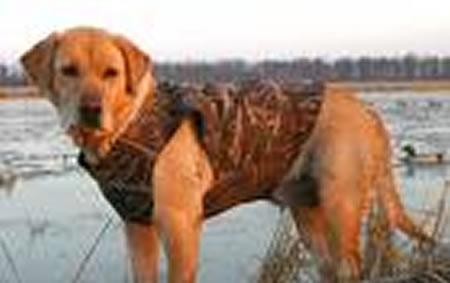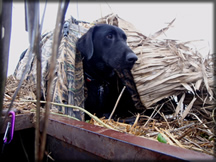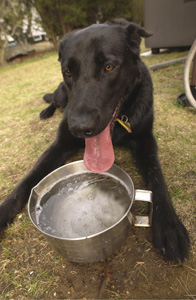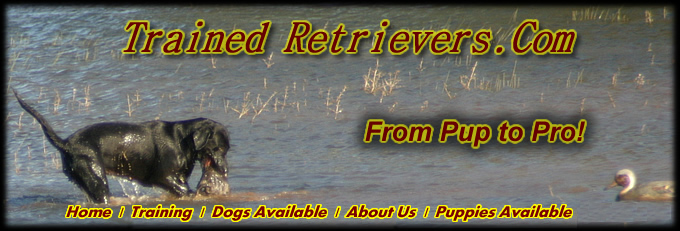Articals: HYDRATE YOUR DOG : HEAT STROKE :
HYDRATE YOUR DOG
Dogs to be used for hunting should start the day well prepared, just as you would. They should be well hydrated and have a light breakfast. They should have water and food available throughout the day. A bite of your ham sandwich does not count here. The energy and nutrition makeup of a good-quality performance food has the best balance of what the dog needs. Carry some dry food with you in a plastic bag. A handful of kibbles every hour or two will keep the dog's body chemistry fit for action or cold.
 Shivering can mean the dog is cold, or that the dog is anticipating the action. It can be a little of both. Make sure you know your dog well enough to know why the dog is shivering. Shivering is a way to generate body heat in a dog, so a little shivering may not mean anything is wrong. Nonstop shivering means the dog is cold, so put yourself in your dogs shoes. If you were sitting in a blind shivering for an hour, odds are you wouldn't be enjoying yourself.
Shivering can mean the dog is cold, or that the dog is anticipating the action. It can be a little of both. Make sure you know your dog well enough to know why the dog is shivering. Shivering is a way to generate body heat in a dog, so a little shivering may not mean anything is wrong. Nonstop shivering means the dog is cold, so put yourself in your dogs shoes. If you were sitting in a blind shivering for an hour, odds are you wouldn't be enjoying yourself.
Keep dogs warm first and foremost by keeping them dry. Dampness is a good conduit for removing heat from the body. Dry a dog by removing the water from the coat top layer, avoid if possible rubbing the dog so hard you kill the air insulation layer next to the skin. Minimize their time in the water. If you have trained your dog to take a straight line in the water, then move so your dog takes the shortest reasonable water route to the bird. A 50 yard swim in icy water can teach a dog to hate retrieving in the water, where a shorter, quick retrieve still lets them have fun without freezing.
 Keep duck dogs out of the water in between retrieves. Keep them out of the wind and out of the moisture. A neoprene coat can be very helpful in keeping the dog warm between retrieves.
Keep duck dogs out of the water in between retrieves. Keep them out of the wind and out of the moisture. A neoprene coat can be very helpful in keeping the dog warm between retrieves.
Upland hunting dogs do not tend to get wet so much as they get hurt. Snowdrift-covered barbed wire, heavy cover and deadfall can be deadly to a dog, or at the very least, extremely abrasive to the face, front and underside of a dog. A protective chest and stomach vest is a must for the upland hunter, particularly in cover of any significance. Boots may or may not be necessary to protect the feet form the same hazards, including stickers, broken rocks or ice, and abrasive vegetation. If the ground is not so harsh, the boots are not necessary, but the vest can only be a benefit to the ardent upland hunter. Orange vests can also  make it easier to spot your dog bobbing through the cover.
make it easier to spot your dog bobbing through the cover.
Upland hunting dogs need water just as much in the cold as they do in the heat. Always carry a container of water, and even if it's cold, watch for signs of overheating. Because you are not in danger of overheating does not mean the track star in front of you is not generating a great deal of body heat.
Rest your dog as often as the dog needs it, not as often as it's convenient to your hunting group. Because a dog will hunt for 3 hours does not mean it should hunt for 3 hours. Rotating dogs usually handles this issue, but if you are hunting with only one, plan on resting the dog before it desperately needs it. Fatigue, cold and injury will take a dog completely out of action, and none of those are necessary if you keep a close enough eye on the situation.
_______________________________________________________________________________

Heatstroke symptoms include:
Exaggerated panting (or the sudden stopping of panting), rapid or erratic pulse; salivation; anxious or staring expression; weakness and muscle tremors; lack of coordination; tongue and lips red (which may eventually turn bluish in colour); convulsions or vomiting; collapse, coma and death.
Emergency Treatment
If your dog shows symptoms of heatstroke follow these instructions:
- Immediately move the animal to a cool, shady place.
- Wet the dog with cool water.
- Fan vigorously to promote evaporation. This process will cool the blood, which reduces the dog's core temperature.
- Do not apply ice. This constricts blood flow which will inhibit cooling.
- Allow the dog to drink some cool water (or to lick ice cream if no water is available).
- Take the dog to a veterinarian as soon as possible for further treatment.
I remember when I sent my girl Rose, to a Kennel when I was on vacation. They worked the dogs durring the hottest part of the summer. When I went to pick her up she just didn't act right. She was very lathargic and quiet. I took her right to the vet and she was treated with intravenous fluids. 4 hours later she was on her way to recovery but tired for 2 days. WATCH YOUR DOGS CLOSELY !



